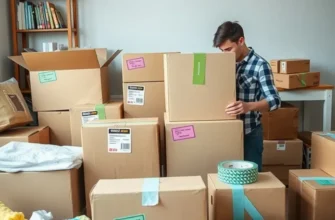If you’re one of those young adults diving headfirst into the world of renting – congratulations! You’re entering a phase of life filled with boundless possibilities, home décor Pinterest boards, and the occasional unexpected IKEA meltdown. Moving furniture can be a Herculean task, especially when you don’t have a mountain of friends on call (or a U-Haul license). Whether you’re shifting that heavy sectional across your living room or lugging a box spring up six flights of stairs, you don’t have to do it alone. This guide is here to make your DIY furniture moving experience smoother than your favorite streaming binge. With a mix of clever hacks and a sprinkle of humor, we’ll tackle everything from planning your move to your big day, ensuring you don’t end up trapped under a coffee table or with a sore back. So roll up your sleeves, channel your inner moving guru, and let’s get started!
The Art of Packing: Organizing for Success

Packing is much like a strategic chess game—every move counts toward your goal of a seamless move. To start, categorize your belongings. Group items by room, purpose, or size. This tactic reduces the tapestry of chaos into manageable patches.
Next, as you begin packing, use labels liberally. Opt for color-coded labels or a simple permanent marker to write on boxes. Note the room and a brief list of primary contents. This practice will save you from having to open multiple boxes to find a single item later.
For furniture, it’s crucial to disassemble what you can. Beds, bookcases, and even some tables are designed to be taken apart. Keep screws, bolts, or small parts in labeled bags and tape them to the corresponding furniture. This prevents any risk of missing essentials when reassembling at your new location.
Consider using protective padding such as blankets or bubble wrap for fragile items or surfaces that risk scratching. Moving blankets can save both your furniture and your moving day mood. Do not underestimate the value of these protective layers.
It’s also wise to follow the heaviest to lightest rule. Load the bulkiest items first, saving lighter boxes for the top layers. This not only balances the load but also minimizes the risk of box collapses during transport.
If this sounds overwhelming, remember there are clever DIY hacks to lighten the load. Use clothing to wrap fragile items, turning packing into a multifunctional task. Vacuum-sealed bags provide an excellent solution for bulky textile items, reducing space and keeping things organized.
When it comes to pre-moving planning, always set aside a “first-night kit“. Pack a separate box or bag with essentials for your first night in the new place—think toiletries, a change of clothes, and basic kitchen supplies. Nothing is worse than rummaging through boxes when you’re exhausted and just want to relax.
Lastly, for electronic equipment, you may find it helpful to check expert advice on packing electronics here. Properly secure wires, gadgets, and screens to avoid unpleasant surprises later.
By harnessing these packing strategies, you will approach moving day with confidence and keep stress at bay. The art of packing is not just about stashing things in boxes but about preparing a thoughtful, ordered transition from one home to the next.
Lifting and Shifting: Making Moves with Ease

Handling heavy furniture during a move doesn’t have to be a daunting task. By mastering a few key techniques, you can turn this chore into a breeze and protect yourself from unnecessary strain. Start by familiarizing yourself with the right lifting techniques to prevent injuries. Bend your knees, not your back, and keep your core engaged as you lift. This way, the power to move comes from your leg muscles, which are stronger and better suited for the job.
Reducing the friction between your furniture and the floor can also make a world of difference. Use items like towels or thick blankets under furniture legs to slide pieces more easily across the room. If you’re dealing with hardwood or tile floors, make sure you protect them from scratches by using furniture sliders. These nifty gadgets reduce friction immensely, so a large sofa becomes almost as easy to move as a coffee table.
Another handy tip is to disassemble what you can. Take apart bed frames, remove drawers from dressers, and separate sectional sofas. Smaller pieces are easier to manipulate and save a great deal of hassle when navigating through tight spaces. As you dismantle items, remember to store screws and small parts in plastic bags. Tape these to the larger pieces, so nothing gets misplaced. This approach not only prevents confusion upon reassembly but also helps in maintaining the furniture’s structure.
When moving items through doors or halls that are tricky to maneuver, the high-low method can be helpful. Tilt furniture like sofas so that one person carries the top and the other carries the bottom. This positioning makes it easier to navigate stairs and narrow spaces.
For challenging moves, consider using a dolly. A two-wheeled dolly is especially useful for large pieces like dressers and boxes. Make sure the items are securely strapped to the dolly to prevent tipping. As you transport heavy loads, check the path ahead to avoid tripping hazards.
Take a moment to plan your path before starting any heavy lifting. Measure doorways and staircases to ensure that your furniture will fit, and remove any obstacles. Clear communication with your moving partner is crucial, so discuss a strategy and use consistent commands during the move to ensure coordination.
Additionally, timing matters. Move during early parts of the day when you have the most energy and conditions are cooler. If you hire external help, work in sync with them to increase efficiency.
Remember, careful packing and thoughtful consideration of the furniture’s dimensions are key to avoiding frustrating scenarios. If small spaces become challenging, consider alternative storage strategies for oversized items until better arrangements can be made. For more insights, check out our guide on budgeting moving costs for tips on optimizing your moving plan economically.
These steps, when combined, go a long way in transforming the physically demanding aspect of moving into something much more manageable and safe. As you hone these skills, your confidence in handling furniture will undoubtedly soar.
Final words
Moving furniture doesn’t have to feel like a scene out of a comedy show. With smart planning and the right techniques, you can transform a seemingly daunting task into a manageable and even enjoyable experience. So, as you embark on this moving adventure, just remember: every scuff on the wall and ache in your back is just a badge of honor on the journey to making your new place feel like home. Embrace the chaos, grab your friends, and let the furniture moving fun begin!









